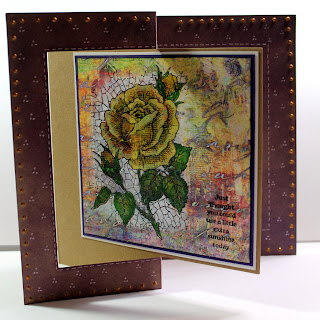If you love colouring there is a wonderful colouring page kit
available from Chocolate Baroque. These are great for making finished pieces
for framing or simply to have fun colouring. The kits also contain a colour
wheel and tips for colour mixing too. The kit is limited edition (so when they
sell out they are gone) and was created using gorgeous hand drawn images from
Sue Page. There are 7 fabulous designs (2 copies of each) plus a couple of
practice pages to test out colouring methods etc.
This is one of the pages that I coloured with alcohol ink
pens plus a bit of sparkle pen. The paper is super smooth and a lovely quality
and the images a joy to colour.
I thought that the designs would be perfect for embroidery.
I first checked the copyright policy on using these designs and provided that the
images are not scanned or photocopied we are permitted to physically hand trace
them onto fabric. I therefore kept my second image as a template for
tracing.
I found that the best method for tracing onto my fabric was
using a light box and a soft pencil. I chose a small motif to try out my
experiments.
I first did an experiment on a scrap piece of fabric and
tried to follow the drawn outlines using free machine embroidery. This is where
the sewing machine feed dogs are disengaged and the fabric is moved and guided under
the needle by hand. This method also requires a special free machine embroidery
or darning foot. Generally the machine is run fairly fast with this technique and
the rate at which you move the fabric beneath the stitching needle determines
the length of stitches achieved (i.e. slowly moving the fabric beneath the needle
gives small close together stitches, fast movements provides longer stitches).
Well what a disaster! I admit that I am a little out of
practice with free machining but I didn’t expect the results to be this bad –
tee hee.
My darning foot has a clear acrylic end but I really could
not see the outlines of the design well enough to stay on track at all while
stitching. Eeek! There are other types of darning foot available, thin metal
circular ends or ones where the front is open or cut away. However, for my high
shank machine they are all pretty expensive at around £30 (there are more
options for standard shank machines and they can be obtained fairly cheaply via
China through EBay).
I really didn’t want to spend out a lot of pennies on
something that I wouldn’t be sure would work for me until I actually got it
home to try. My ideal would be no foot getting in the way at all so that I would
have a complete clear view of the needle. I tried stitching with the foot
removed (NB. Even with no actual foot in place the presser foot mechanism must
be lowered in order to engage the tension discs on the needle thread). This was
perfect for aligning my stitching along the design but caused bad stitch
quality and skipped stitches. While operating the fabric bounced around too
much (even though in an embroidery hoop) as there was no foot to hold the
fabric while the needle pushed through and pulled out of the layers.

I then investigated further and found that there is such a
thing as a free
machine spring needle that can be used without a foot. These are not all
that cheap either (£5), considering that like any needle they do wear out with
use. However, it was a much cheaper option for me and gave perfect vision of my
stitching outlines while working. It should last me a while too if I keep it
just for projects that need detailed and accurate stitching.
I chose 2 layers of hand dyed cotton fabric with a layer of thin
polyester wadding between (to give a little quilting texture). I used a small
spring hoop to hold it all in place and stabilise my fabric layers. I chose a
variegated embroidery thread for stitching and I was delighted with the
results. Yay!
I didn’t really have a plan of what I was going to make but
decided to turn it into a small padded pouch for my mobile phone.
Finally I decided to add a little colouring to the quilted
design. I used Inktense pencils to add shading and then dragged out the colour
using a damp brush (this makes the pigment permanent). I learned a lot making
this project and I love my little phone pouch.
I have written a bit of an essay but I hope this helps
anyone else trying out some free machine embroidery x.














































